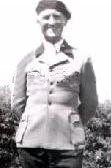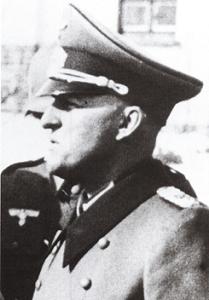|

|
|
|
|
Divisionskommandeur
(12.11.1943 - 15.03.1944)
(m.F.b) 01.06.1943 - 12.11.1944
Generalleutnant
Otto Heinrich WalterKurt Kruse (DKiG)


Personalien:
Geburtsdatum: 12.06.1895
Geburtsort:
Neustrelitz / Mecklenburg- Strelitz
Todestag:
30.05.1983
Todesort:
Bielefeld / Nordrhein- Westfalen
Religion:
ev.
Größe:
178cm
Gewicht:
80 Kg
Haarfarbe:
blond
Augenfarbe:
grau
Generalleutnant Kurt KRUSE
- DKiG: am 23.02.1944 als Generalmajor und Kommandeur der 389.
Infanterie-Division
- RK des Kgl. Preuss. Hausordens von Hohenzollern mit Schwertern: 02.10.1918
- EK I: 16.02.1917
- EK II: 22.10.1914
- Grossherzoglich Mecklenburg-Strelitzsches Verdienstkreuz für Auszeichnung
im Kriege II. Klasse: 30.06.1915
- Grossherzoglich Mecklenburg-Strelitzsches Verdienstkreuz für Auszeichnung
im Kriege I. Klasse: 02.08.1917
- Verwundetenabzeichen, 1918, in Schwarz: 15.10.1918
- Ehrenkreuz für Frontkämpfer: 21.12.1934
- Wehrmacht-Dienstauszeichnung IV. bis II. Klasse
- Wehrmacht-Dienstauszeichnung I. Klasse: 18.03.1939
- Spange zum EK II: 26.05.1940
- Spange zum EK I: 19.06.1940
- Medaille “Winterschlacht im Osten 1941/1942“: 12.08.1942
- Kriegsverdienstkreuz II. Klasse mit Schwertern: 01.09.1943
Promotions:
| - Fahnenjunker |
18.03.1914 |
| - Fahnenjunker-Unteroffizier |
18.06.1914 |
| - Fähnrich |
26.09.1914 |
| - Leutnant |
24.11.1914 |
| - Oberleutnant |
20.06.1918 |
| - Hauptmann |
01.01.1928 |
| - Major |
01.11.1934 |
| - Oberstleutnant |
01.08.1937 |
| - Oberst |
01.07.1940 |
| - Generalmajor |
01.11.1943 |
| - Generalleutnant |
01.05.1944 |
| |
|
|
-
Schooling: Attended the Carolinum Gymnasium (High School) in
Neustrelitz and Humanistic Gymnasium in
Wiesbaden; attained his certificate of graduation from the latter
institution.
-
18
March 1914: Entered the Army as a Fahnenjunker in the 1. Posensches
Feld-Artillerie-Regiment Nr.20.
-
13-17
January 1916: Detached to the Gas Defense Course.
-
5
March 1916: Wounded by mortar fragments/treated at the front and remained
with the troops.
-
3
June 1916: Adjutant of the II. Battalion of Field Artillery Regiment 20.
-
9
July 1918-22 March 1919: Leader of the 6th Battery of Field Artillery
Regiment 20.
-
23
March 1919-11 April 1919: Leader of the Volunteer Battery of Field
Artillery Regiment 20.
-
12
April 1919: Joined the infantry escort battery
of Self-Defense Battalion “von der Decken”
(IV./Infantry Regiment 50) as the Battery
Leader.
-
10
July 1919: Placed in Field Artillery Regiment 20 while retaining his
previous post as Battery Leader (later Battery “Kruse”).
-
15
February 1920: Due to the dissolution of Field Artillery Regiment 20,
Battery “Kruse” was transferred to Light Reichswehr Artillery Regiment 5
of Reichswehr-Brigade 5.
-
21
September 1920-21 December 1920: Detached to the Artillery Measuring
School at Jüterbog.
-
1
October 1920: Transferred to the 2nd (Prussian) Artillery Regiment
upon the formation of the new Reichsheer from the Übergangsheer or
Transitional Army.
-
15 February 1923-29 March 1923: Detached to the Sound
Measuring Course at the Inspectorate of Weapons and Equipment.
-
15
January 1927-1 April 1927: Detached to the 2nd (Prussian) Motorized
Battalion for driving training receiving three driver’s licenses: Class I
(motorcycle), Class II (truck) and Class IIIb (passenger car).
-
1
October 1927: Transferred to the 1st Company of the 2nd (Prussian)
Transport Battalion until 31 October 1927.
-
1
November 1927: Transferred to the 2nd (Prussian) Artillery Regiment.
-
1
October 1928: Detached to the Measurement Section of the
Army Department
(T
1)/Troop Office/Reich Defense Ministry.
[The T 1 department was responsible for Army operational planning. As
such, it handled all matters relating to the internal and external
military situation, border defense, land fortifications, troop employment
and organization, military transportation and military measurement,
mapping and charting.]
-
25
September 1930-5 November 1930: Detached to the Firing Course for
Artillery Officers at Jüterbog.
-
1
October 1930: Chief of the 7th Battery of the III. Battalion of the 3rd
(Prussian) Artillery Regiment, Jüterbog.
-
15
July 1931-15 August 1931: Detached to artillery troop units in Russia.
-
1
October 1934: Commander of the I. Battalion of Artillery Regiment “Jüterbog,”
redesignated the Artillery Demonstration Regiment on 1 May 1935.
-
15
June 1936: Commander of the II. Battalion of Artillery Regiment 42.
-
27
August 1939-19 October 1941: Commander of Artillery Regiment 186 of the
86th Infantry Division. [While the cream of the
German military invaded Poland in September 1939, the
86th
Infantry Division, commanded by Generalmajor
Joachim Witthöft, served on border defense duty along the western frontier
of Germany as a component of General der Infanterie Curt Liebmann’s 5th
Army. After taking part in the invasion of France under Generaloberst
Wilhelm List’s 12th Army in 1940, the division remained there on
occupation duty until transferring to the Eastern Front in July 1941.
Initially held in reserve, the 86th Infantry Division was committed to
battle that summer as a component of the 9th Army (Generaloberst Adolf
Strauß and then General der Panzertruppe/Generaloberst Walter Model from
15 January 1942) of Army Group Center and saw action at Smolensk, Vyasma
and Rzhev.]
-
20
October 1941-17 January 1942: Staff Officer for Artillery in the General
Staff of the 9th Army on the Eastern Front.
-
18
January 1942-19 February 1942: Delegated with the deputy leadership of the
110th Infantry Division on the Eastern Front.
-
20
February 1942-20 April 1942: Higher Artillery Commander (Harko) 307 of the
9th Army on the Eastern Front.
-
21
April 1942-30 July 1943: Course Leader at Artillery School I in Berlin.
-
1
August 1943: Transferred to the Army High Command Leader Reserve.
-
15
August 1943: At the same time, detached to Army Group South for employment
as a deputy division commander.
-
15
August 1943-16 September 1943: Delegated with the deputy leadership of the
294th Infantry Division on the Eastern Front.
-
17 September 1943-11 November 1943: Delegated with the
deputy leadership of the 17th Infantry Division on the Eastern Front. [An
evaluation dated 27 December 1943 prepared by General der Infanterie
Friedrich Mieth, the Commanding General of the
IV Army Corps, assessed Generalmajor Kruse’s personal and professional
qualities: Open, direct character; fresh, zestful, energetic
personality. Brave and ready for action. Mentally very well disposed and
flexible. During his short assignment under the IV Army Corps, he has led
his division prudently and made well thought out preparations for
large-scale combat. Strong Points: Freshness, drive and energy, good
tactics—particularly artillery tactics, ability and knowledge.
Generaloberst Karl Hollidt, the Commander-in-Chief of the 6th Army, added
his own comments to the evaluation: In the autumn of 1942,
Generalmajor Kruse led the 294th and 17th Infantry Divisions in heavy
defensive combat confidently and energetically and also rose to the
occasion in difficult situations. Excellent division commander who stands
far above average.]
-
12
November 1943-15 March 1944: Commander of the 389th Infantry Division on
the Eastern Front. [After rebuilding, the
division transferred to Russia in October 1943 where it was assigned to
General der Infanterie Otto Wöhler’s 8th Army under Army Group South. On
24 January 1944, the Russian 2nd Ukrainian Front, commanded by General
(later Marshal of the Soviet Union) Ivan S. Konev, launched powerful
probing attacks followed by a large-scale offensive the next day against
the 8th Army’s positions between Cherkassy and Kirovograd. Bearing the
brunt of the attack, the 389th Infantry Division took a severe beating and
quickly fell back in scattered battle groups. In March 1944, the battered
division transferred to western Hungary for a much needed rest and
refitting.]
-
15
March 1944-5 November 1944: Higher Artillery Commander (Harko) 317 of the
14th Army in Italy.
-
6
November 1944-14 December 1944: Higher Artillery Commander of the 6th
SS-Panzer Army on the Western Front.
-
15
December 1944-14 January 1945: Higher Artillery Commander (Harko) 506 of
Army Group B on the Western Front.
-
15
January 1945: Transferred to the Army High Command Leader Reserve – duties
determined by the Deputy Commanding General of
the VI Army Corps and the Commander of Wehrkreis [Military District] VI,
Münster.
-
20
January 1945: Delegated with the position of Artillery General for Special
Employment 4.
-
5 May
1945-17 May 1948: Prisoner of war in British captivity.
Decorations & Awards:
-
German Cross in Gold: 23 February 1944, Generalmajor,
Commander of the 389th Infantry Division.
-
Prussian Royal Hohenzollern House Order, Knight’s Cross
with Swords: 2 October 1918.
-
Prussian Iron Cross, 1st Class (1914): 16 February
1917.
-
Prussian Iron Cross, 2nd Class (1914): 22 October 1914.
-
1939 Bar to the Prussian Iron Cross, 1st Class: 19 June
1940.
-
1939 Bar to the Prussian Iron Cross, 2nd Class: 26 May
1940.
-
War Merit Cross, 2nd Class with Swords: 1 September
1943.
-
Medal for the Winter Campaign in Russia 1941/1942
(“East Medal”): 12 August 1942.
-
Mecklenburg-Strelitz Merit Cross for Distinction in
War, 1st Class: 2 August 1917.
-
Mecklenburg-Strelitz Merit Cross for Distinction in
War, 2nd Class: 30 June 1915.
-
Cross of Honor for Combatants 1914-1918: 21 December
1934.
-
Armed Forces Long Service Award, 1st Class (25-year
Service Cross): 18 March 1939.
-
Armed Forces Long Service Award, 3rd Class (12-year
Service Medal)
-
Wound Badge in Black – World War I award: 15 October
1918.
Generalleutnant Kruse’s World War I Combat Service
Record
Western Front, 1914-1918
-
22-27 August 1914:
Battle of Longwy—Longuyon and the Othain Sector.
-
28 August 1914-1 September 1914: Battle of the Maas
Crossings [Battle on the Maas].
-
30 August 1914-5 September 1914: Pursuit from the Maas
to the Marne.
-
18 September 1914-20 February 1916: Combat between the
Maas and the Mosel.
-
21 February 1916-4 July 1916: Battle of Verdun.
-
7 July 1916-1 October 1916: Battle on the Somme.
-
26 October 1916-23 December 1916: Positional combat
before Verdun.
-
7-16 April 1917: Positional combat in Upper Alsace.
-
20 April 1917-10 May 1917: Combat on the “Siegfried”
Front.
-
11-20 May 1917: Spring Battle at Arras 1917.
-
21 May 1917-13 June 1917: Positional combat in Flanders
and Artois.
-
9 July 1917-20 November 1917: Battle in Flanders.
-
21-29 November 1917: Tank battle at Cambrai.
-
30 November 1917-7 December 1917: Attack battle at
Cambrai.
-
8-23 December 1917: Combat in the “Siegfried” Position.
-
12-18 March 1918: Preparation time for the Great Battle
in France and combat in the “Siegfried” Position.
-
21 March 1918-6 April 1918: Great Battle in France (“Ludendorff
Offensive”).
-
21-22 March 1918: The breakthrough between Gouzeaucourt
and Vermand.
-
23-26 March 1918: Pursuit action in the Somme area.
-
7 April 1918-5 May 1918: Combat on the Ancre, Somme and
Avre.
-
24-26 April 1918: Battle at Villers-Bretonneux, on the
Luce and Avre.
-
23-26 May 1918: Positional combat north of the Ailette.
-
27-31 May 1918: Battle of Soissons and Reims.
-
1-8 June 1918: Combat on the Avre and at Montdidier and
Noyon.
-
9-13 June 1918: Battle of Noyon.
-
7-14 July 1918: Positional combat at Reims.
-
15-17 July 1918: Attack battle on the Marne and in
Champagne.
-
26 July 1918-3 August 1918: Mobile defensive battle
between the Marne and the Vesle.
-
4-16 August 1918: Positional combat between the Oise
and the Aisne.
-
17 August 1918-4 September 1918: Defensive battle
between the Oise and the Aisne.
-
5-8 September 1918: Combat before the “Siegfried” Front
1918.
-
9-18 September 1918: Combat in the “Siegfried” Position
with the 9th Army.
-
NOTE: The final few
entries in Kruse’s World War I battles/engagements list are missing from
his Dienstlaufbahn or service record.
-
6-11 February 1919: Combat against Poland (mobile unit
of the 10th Infantry Division).
Quelle
Zurück zur Startseite |
|